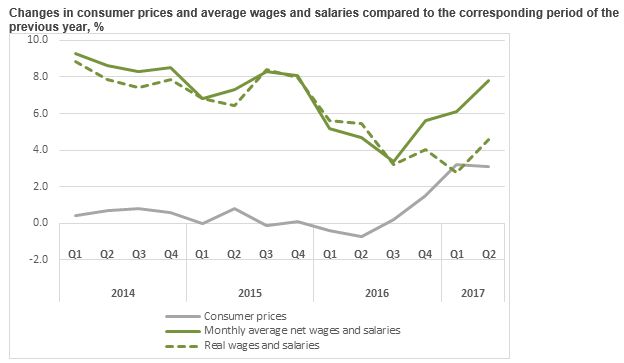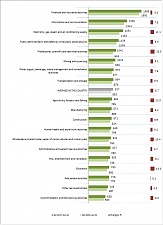Analytics, Financial Services, Latvia, Markets and Companies, Wages
International Internet Magazine. Baltic States news & analytics
Saturday, 14.06.2025, 21:11
Average gross earnings have exceeded 900 euros in Latvia in Q2
 Print version
Print versionCompared to the previous
quarter, in the 2nd quarter of 2016 the increase in the gross
wages and salaries comprised 4.8% (42.7 euros).
Compared to the 2nd quarter
of 2016, in the 2nd quarter of 2017 gross wages and salaries
fund rose by 9.1% or 173.2 million euros, whereas the number of
salaried workers grew only by 0.3% or 2.5 thousand (recalculated into
full-time units).
Changes in average monthly gross wages and salaries by sector, euros
|
|
Q2 2016 |
Q1 2017 |
Q2 2017 |
Changes, % |
|
|
Q2 2017
compared to Q2 2016 |
Q2 2017
compared to Q1 2017 |
||||
|
Total |
853 |
885* |
927 |
8.7 |
4.8 |
|
Private
sector |
839 |
879* |
915 |
9.1 |
4.1 |
|
Public
sector |
882 |
897 |
954 |
8.2 |
6.3 |
|
of which: |
|
|
|
|
|
|
general government
sector |
824 |
847 |
901 |
9.3 |
6.4 |
In the 2nd quarter
of 2017, the average net wages and salaries constituted 676 euros, which
was 7.8% more than in the 2nd quarter of 2016. In general, the
average net wages and salaries rose slower than the earnings before taxes.
As of 1 January 2017, the
minimum untaxed minimum applied on the workplace was reduced from 75 euros to
60 euros, and minimum national wage rose from 370 euros to 380 euros or by 2.7%.
The increase in consumer
prices registered in the 2nd quarter of 2017 (of 3.1%, compared
to the corresponding period of the previous year) had downward effect on the
purchasing power of the employed population – real wages and salaries grew only
by 4.6%.
Compared to the 2nd quarter of 2016, in the 2nd quarter of this year the rise of wages and salaries in private sector constituted 9.1%, in public sector 8.2% and in general government sector 9.3%.

 |
|---|
Compared to the 2nd quarter
of 2016, in the 2nd quarter of this year the rise of wages and
salaries in private sector constituted 9.1%, in public sector 8.2% and in
general government sector 9.3%.
In the 2nd quarter
of 2017, the average gross wages and salaries amounted to 915 euros in the
private sector and to 954 euros in public sector, whereas in general
government sector, which includes central and local government institutions, as
well as enterprises controlled and financed by the central and local
government, the average gross wages and salaries amounted to 901 euros.
Compared to the corresponding
quarter of the previous year, in the 2nd quarter of 2017 the
increase in wages and salaries was recorded in all sectors. The sharpest rise
in average wages and salaries was observed in professional, scientific and
technical activities (that include legal and accounting activities, advertising
and market research, architectural and engineering activities, management
consultancy activities, scientific research and development, etc.) – of 13.5%
(with the sharpest increase in activities of head offices; management
consultancy activities, as well as advertising and market research),
education – of 13.0%, electricity, gas, steam, and air conditioning supply – of
11.1%, agriculture, forestry and fishing – of 11.0%, as well as trade – of 10.4%
(with the most notable growth in wholesale and trade and repair of motor vehicles
and motorcycles, as well as other wholesale).
In all mentioned highest-level
sectors of the classification of economic activities, except for electricity,
gas, steam, and air conditioning supply, the rapid increase in the average
wages and salaries was influenced by the rise in the wage and salary fund and
decline in the number of full-time employees. Whereas increase in the average
earnings in electricity, gas, steam, and air conditioning supply was
significantly affected by irregular premiums and bonuses (basic salary and
regular premiums grew by 6.2% during the year).
In the 2nd quarter
of 2017, the highest wages and salaries for full-time work were registered in
financial and insurance activities, information and communication and energy
sectors. Wages and salaries exceeding the national average indicator were also
recorded in public administration, professional, scientific and technical
activities, mining and quarrying, water supply; sewerage, waste management and
remediation activities, as well as transportation and storage. The lowest wages
and salaries, in turn, were observed in accommodation and food service
activities, other service activities (that includes activities of public and
other organisations, repair of computers and personal and household goods,
washing and (dry-)cleaning, hairdressing and other beauty treatment, funeral
and related activities), real estate activities, education, arts, entertainment
and recreation.
Compared to the 2nd quarter
of 2016, in the 2nd quarter of 2017 regional breakdown shows
that the average monthly gross wages and salaries in all regions rose faster
than the national average, except for Riga. Vidzeme and Zemgale indicate the sharpest
annual rise – of 10.5% and 10.1%, respectively. In the 2nd quarter,
the annual increase in Riga having the highest wages and salaries
(1038 euros) constituted 7.9%. Lower average gross wages and salaries
still were observed in Latgale region – 643 euros for full-time work,
followed by Vidzeme with 740 euros, Kurzeme with 774 euros, Zemgale
with 784 euros, whereas indicator registered in Pierīga region amounted to
888 euros.
More information on wages and
salaries in Latvia is available in the CSB website section Wages and Salaries – Key Indicators. Data on wages and salaries are published in the database section Wages
and Salaries (Short term statistical data and Annual statistical data).
Methodological explanations
* Data are revised.
Data on the beginning of the
year are revised each quarter in line with the routine data revisions defined
in the CSB Revision Policy guidelines, as new economically active enterprises
and institutions are added to the population of the statistical units surveyed,
kinds and sectors of economic activities of enterprises are specified,
additional or specified information from respondents or updated data from
administrative data sources are received.
The data source used for wage
and salary statistics is the sample survey of individual merchants, commercial
companies, state and local government institutions, foundations, associations
and funds, as well as administrative data sources.
The CSB calculations of
average wages in public sector include central and local government
institutions and their commercial companies, companies with central or local
government capital participation of 50% and over, excluding foundations,
associations, funds, and their commercial companies.
According to the European
System of Accounts, the general government sector includes central and local
government institutions, social security fund, enterprises controlled and
financed by the central and local governments.
The changes in the average
monthly wages and salaries are calculated as not-rounded values, i.e., taking
into account the value in euro cents.
When calculating the average
monthly wages and salaries, the number of salaried employees is re-calculated
into full-time units, thus eliminating the differences in salaries paid for
different workloads.








 «The Baltic Course» Is Sold and Stays in Business!
«The Baltic Course» Is Sold and Stays in Business!

